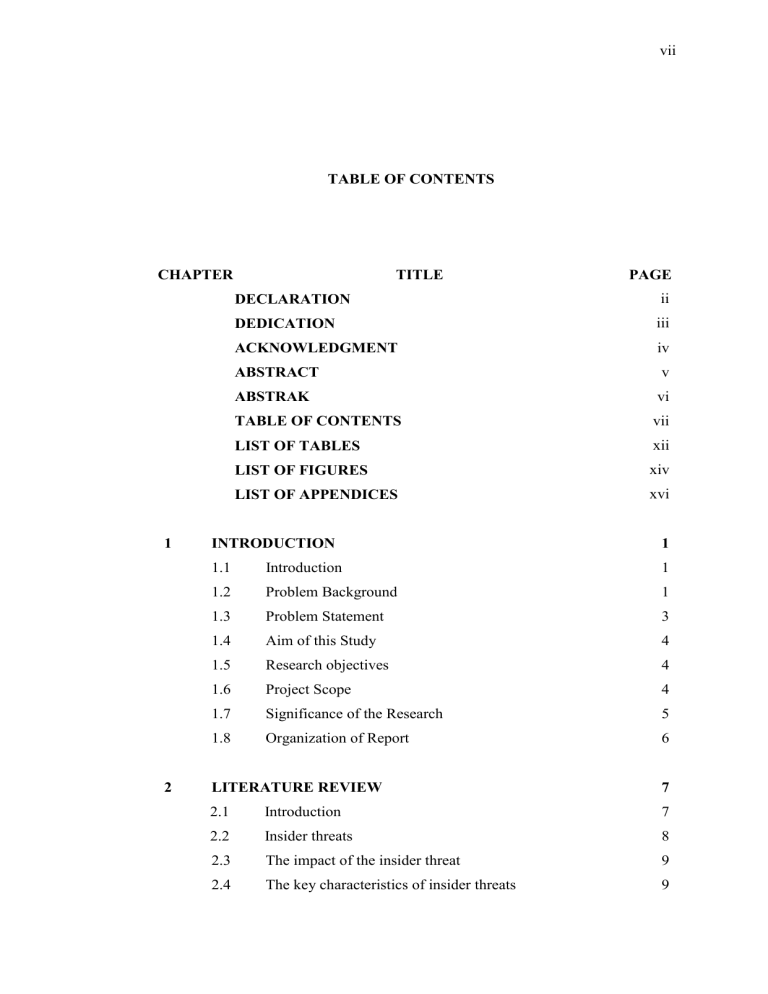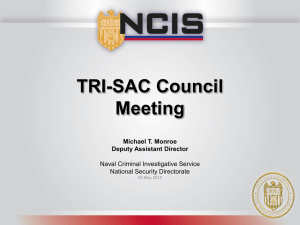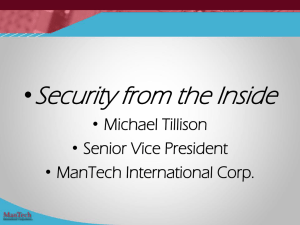Document 14927205
advertisement

vii TABLE OF CONTENTS CHAPTER 1 2 TITLE PAGE DECLARATION ii DEDICATION iii ACKNOWLEDGMENT iv ABSTRACT v ABSTRAK vi TABLE OF CONTENTS vii LIST OF TABLES xii LIST OF FIGURES xiv LIST OF APPENDICES xvi INTRODUCTION 1 1.1 Introduction 1 1.2 Problem Background 1 1.3 Problem Statement 3 1.4 Aim of this Study 4 1.5 Research objectives 4 1.6 Project Scope 4 1.7 Significance of the Research 5 1.8 Organization of Report 6 LITERATURE REVIEW 7 2.1 Introduction 7 2.2 Insider threats 8 2.3 The impact of the insider threat 9 2.4 The key characteristics of insider threats 9 viii 2.5 2.6 2.4.1 Trust 10 2.4.2 Access 10 2.4.3 Knowledge and skills 10 2.4.4 Security perimeter 11 Categorizing insiders 11 2.5.1 Pure insider 12 2.5.2 Insider associate 12 2.5.3 Insider affiliate 13 2.5.4 Outside affiliate 13 Insider threat and threat agents 14 2.6.1 Insider threat capability 15 2.6.2 Insider threat motivation 15 2.6.3 Insider threat opportunity 16 2.7 End user security behavior 17 2.8 Insider threat profiles 19 2.9 Classification of countermeasure of Insider Threats 22 2.9.1 22 2.10 Technical-, Formal- and Informal controls Factors affecting human behavior in the of shifting technical, social, business and cultural factors 2.10.1 2.10.2 2.10.3 26 Technical and social factors affecting the insider threat 26 2.10.1.1 Technology is impacting on social interactions 26 2.10.1.2 Security is not keeping up with technological and social changes in the workplace 27 Business and economic factors affecting the insider threat 28 2.10.2.1 Outsourcing can increase insider risks 28 2.10.2.2 The global recession is affecting insider Behavior 28 Cultural factors affecting the insider Threat 29 ix 2.11 29 2.10.3.2 Regional culture 30 The importance of non-technical mitigations for the insider threat 2.11.1 2.12 2.10.3.1 Organizational culture 30 Enforce baseline security policies and Procedures 30 2.11.2 Extend traditional policy and guidance 31 2.11.3 Conduct ongoing personnel checks 31 Existing Frameworks for human behavior to mitigate the insider threats 31 2.12.1 A framework for insider threats 32 2.12.1.1 The Organization 32 2.12.1.2 The System 33 2.12.1.3 The Individual 34 2.12.1.4 The environment 34 End user security behavior 35 2.12.2.1 The body of knowledge 36 2.12.2.2 The behavior demonstrated by senior management 36 2.12.2 2.12.2.3 The user’s security common sense and decision making skills 2.12.2.4 The user’s personal values and standards of conduct 37 The user’s sense of obligation 37 The difficulty in complying 38 2.12.2.5 2.12.2.6 2.12.3 2.12.4 36 Insider Prediction Model 38 2.12.3.1 User Taxonomy 39 2.12.3.2 Psychological Profiling 40 2.12.3.3 Real Time Usage Profiling 40 2.12.3.4 Decision Manager 40 Framework for relations between threat, countermeasure, human factor and behavior 41 x 2.12.4.1 Information security Internal Threat 42 Countermeasures to mitigate insider threats 42 2.12.4.3 Human factors 43 2.12.4.4 User Behavior 44 2.12.4.2 2.13 3 Summary 53 METHODOLOGY 55 3.1 Introduction 55 3.2 Research Methodology 55 3.3 Operational Framework 56 3.3.1 Phase 1 59 3.3.2 Phase 2 60 3.3.2.1 Compose the questionnaire 61 3.3.2.2 Distributing the questionnaire 61 Phase 3 62 3.3.3.1 Analyze the questionnaire 62 3.3.3 3.4 4 Summary 63 FRAMEWORK IMPLEMENTATION 64 4.1 Introduction 64 4.2 Conceptual Framework for Human Behavior to Mitigate of Insider Threat 64 4.2.1 User Motivation 66 4.2.2 Organizational security culture 66 4.2.3 User Training 67 4.2.4 Security Knowledge 68 4.2.5 Security policy 68 4.2.6 Decision making skills 68 4.2.7 User Personal Value 69 4.3 Summary 69 xi 5 ANALYSIS AND RESULT 70 5.1 Introduction 70 5.2 Validation the Components Framework of Human Behavior to Mitigate the Insider Threat 5.2.1 Demographics 70 71 5.2.2 User Motivation 72 5.2.2.1 5.2.3 5.2.4 5.2.5 73 5.2.2.3 Facilities 74 Security Organizational Culture 75 5.2.3.1 Attitude 76 5.2.3.2 Trust 77 User Training 5.2.4.1 Security Awareness 78 5.2.4.2 Skills 79 Security knowledge Security policy awareness, standards and procedures 80 80 5.2.6 Security policy 81 5.2.7 Decision making skills 83 5.2.7.1 Capability 83 5.2.7.2 Opportunity 84 5.2.8 5.4 72 5.2.2.2 Rewards 5.2.5.1 5.3 Increasing Employee’s Salary User personal values 85 Recommendations from the Expert 87 5.3.1 User motivation 87 5.3.2 Security Organizational Culture 87 5.3.3 User Training 88 5.3.4 Security knowledge 88 5.3.5 Security policy 89 5.3.6 Decision Making Skills 89 5.3.7 User Personal Values 90 Components of human behavior to mitigate the insider Threat 90 xii 5.5 5.6 6 Framework of human behavior to mitigate the insider threat 94 Summary 96 DISCUSSION AND CONCLUSSION 6.1 Introduction 97 6.2 Project Achievement 97 6.3 Project Constraints 98 6.4 Future Works 99 6.5 Summary 99 REFERENCES 100 APPENDIX A 104 APPENDIX B 111 APPENDIX C 118 xiii LIST OF TABLES TABLE NO. TITLE PAGE 2.1 The Insider Threats Profiles 21 2.2 The Countermeasure on Insider Threat 25 2.3 Conceptual frameworks for human behavior to mitigate the Insider Threats 45 2.4 Features of existing Framework 47 2.5 The strength and weakness of existing Human Behavior framework to mitigate Insider Threats 49 Selected Components of the Insider Threat Framework 51 3.1 Details of Research Methodology 57 5.1 Demographic Characters of Questionnaire Respondents 72 5.2 Violate the Security Policy 83 5.3 User Personal Values 86 5.4 Contribution of selected components of Human Behavior to mitigate the Insider Threat 91 2.6 xiv LIST OF FIGURES FIGURE NO. TITLE PAGE 2.1 Categories of Insiders 13 2.2 Factors contributing to the creation of an Insider Threat 14 2.3 The Components of Capability 15 2.4 The Components of Motivation 16 2.5 The Components of Opportunity 17 2.6 ABC Model 18 2.8 Frameworks for Insider Threats 32 2.9 Factors that influence User Security Behavior 35 2.10 Insider Threat Prediction Model 39 2.11 Relation between Threats, Countermeasure, Human Factors, Behaviors 41 3.1 Operational Framework of the Research 57 4.1 Conceptual Framework Human Behavior to Mitigate of Insider Threat 65 Influencing information security behavior and cultivating an information security culture. 67 5.1 Motivation by increasing employee’s salary 73 5.2 Rewards for employees 74 5.3 Facilities for Employees 75 5.4 Attitude of employees in an organization 76 5.5 Trust in an organizational culture 77 5.6 Security awareness 79 5.7 Employee skills 80 5.8 Security Knowledge 81 5.9 Security policies in an Organization 82 4.2 xv 5.10 Capability 84 5.11 Opportunity 85 5.12 Proposed Framework of Human Behavior to mitigate the Insider Threat 95 xvi LIST OF APPENDICES APPENDIX TITLE PAGE A Questionnaire Form 104 B Answered Questionnaire Form 111 C Interview Form 118




